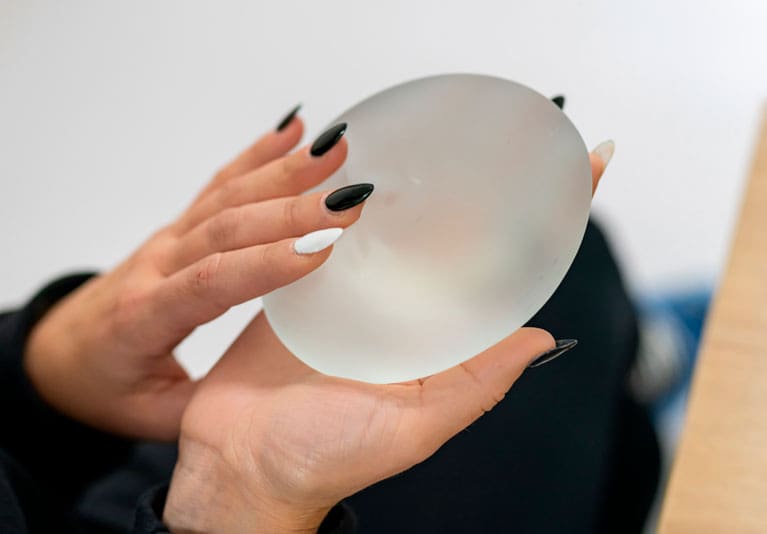There are general surgical risks associated with a breast augmentation operation, including discomfort, bleeding, swelling and infection. Having a general anaesthetic can also give a small risk of developing a blood clot. Occasionally there are additional complications that can arise from the implants themselves. These complications include: rupture or leaking of the implant, build-up of fluid or bleeding around the implant, rotation of the implant or change in the shape of the breasts in the long term due to the formation of internal scarring (capsule). All of these risks are mitigating with careful pre-operative planning, excellent surgical technique and thorough post-operative care and follow up.
Restorative Surgical Procedures by Mr Ioannis Goutos
Breast Augmentation London

At a glance
Treatment time:
Surgery typically takes 1-2 hours.
Duration:
Long-lasting effects; final results may be altered in the event of pregnancy or significant weight changes. Most implants can remain in place for 10-15 years on average.
Return to work:
7-14 days for light duties and office-based work, with 6-8 weeks break recommended before resuming vigorous physical activities.
Anaesthetic:
Usually done under a general anaesthetic (meaning that you will be asleep throughout the surgery).
Breast augmentation is a surgical procedure we perform at our London clinic to enlarge the breasts most commonly by inserting implants. An alternative method of breast enlargement involves fat grafting, in other words removing fat from one area of the body and reinjecting it within the breast.
Individuals may be interested to have a breast augmentation operation for a number of different reasons. Some women may feel that their breasts are too small, asymmetrical or out of proportion to the rest of their body. The breasts themselves can become droopy or saggy with age or following pregnancy or weight loss.
Breast augmentation is a significant operation and it is important to undergo a thorough assessment and discuss your problems and treatment goals with an experienced plastic surgeon. Some women may benefit from breast lift surgery, which aims to reshape the breasts rather than change the overall size. Breast augmentation can be done alongside a breast lift in order to achieve the desired results. By discussing your cosmetic goals with an experienced surgeon, they will be able to recommend the best procedure for you and your goals.
Mr Ioannis Goutos is a technically skilled plastic surgeon with a wealth of experience delivering a number of non-surgical and surgical cosmetic procedures. He has a special interest in managing scars and burns, and also body contouring procedures. His London-based clinic offers full assessments, pre-operative planning, procedures and excellent post-operative care. Mr Goutos takes pride in creating bespoke treatment plans for each individual based on their concerns, medical background and treatment goals.
Book your consultation today
Book nowHow does breast augmentation work?
Breast augmentation surgery is usually done under a general anaesthetic. Prior to the operation, it is essential to undergo a thorough pre-operative assessment to ensure that it is safe for you to have the surgery and anaesthetic. This typically involves a review of your medications, any past surgical history or medical problems and a general physical examination, which may include some additional basic tests. During your pre-operative assessment, your surgeon will be able to discuss different implant options. Breast implants can vary in their material, texture, size and shape. It is crucial that the correct implant type is selected for each individual based on their current breast size and shape, size of the ribcage and their aesthetic goals. Implants can be made of silicone gel (either round or tear drop shaped) or filled with saline. Different types of implant can affect the overall shape, projection and firmness of the breasts.
On the day of the operation, your surgeon will take time to mark out the existing contours of the breast as well as the proposed incisions. This is mapped out carefully to ensure symmetrical results. Incisions are typically made under the breast or around the areola. This means that the final scarring is not as noticeable, or the surgeon can disguise the scarring with repositioning of the nipple. Once safely under anaesthesia, the pre-selected implants are inserted underneath the breast tissue itself, or deeper under the chest wall muscles. At this stage, the surgeon may also remove small portions of skin to allow for re-draping of the remaining tissues to produce the desired overall contour. In cases where a large increase in the breast volume is indicated, tissue expander surgery may be recommended before breast augmentation to ensure there is adequate skin to accommodate the enlarged breasts. Once the implant is in place, the surgical wound is closed using stitches and a supportive dressing is left in place.
Most people can go home on the same day as the surgery, but will need someone to drive them home and stay with them for 24-48 hours following the anaesthetic. In some cases longer observation is needed, in which case patients can expect an overnight stay in hospital. It is recommended to wear a firm, supportive dressing for at least the first week or two to facilitate good healing of the wound. It is important to monitor the wound during this time to ensure there is no infection or problems with the implants. Following this, it is advised to wear a soft, supportive bra with no underwire during the day and night for up to 3 months until the wound has completely healed and the breast tissue and implants have settled. Most people can return to work in 7-14 days, with a 6-8 week interval of rest recommended before commencing strenuous physical activity.


Breast Augmentation Frequently Asked Questions
We know having medical, surgical or cosmetic treatment can seem daunting and it is natural to have questions. We are here to ensure your comfort and safety at all times. If you are unable to find the answer to your questions below, then please do not hesitate to contact us so we can help.
Most breast implants are safe to remain in place for 10-15 years. In the case of complications with the implants, they may require removal sooner. In some individuals, where there are no issues with the implants, they may remain in place for longer.
The incisions made for breast augmentation are made either under the breast or around the areola. If made under the breast, this can be done respecting the natural contour of the skin to reduce the appearance of the resultant scarring. If incisions are made around the areola, the wound can be closed in a way that the scarring is disguised by the areola and nipple margin. If you are known to develop problem scarring, such as hypertrophic of keloid scars, it is recommended to discuss this with your surgeon prior to your operation, as additional measures can be taken to promote good quality scar formation.
Breast cancer screening is carried out using mammograms: a type of X-ray imaging. The mammogram will not have any effect on the implant itself, however the X-rays are not able to penetrate the implants. It is important to let your provider know that you have breast implants prior to having a mammogram so that additional measures can be taken to ensure thorough breast screening.
How much does breast augmentation in London cost?
Prices start from £4500
At Goutos London, we aim to deliver a premium service with no compromise on quality in order to deliver the best results possible for your needs.

Related conditions
Whatever your condition, and whatever your health goals are, we will ensure you get a holistic, focused and bespoke service that offers you the safest options for treatment aiming for the best possible outcome.
Testimonials
Mr Goutos is delighted to share some of his patient and peer feedback on their experiences of his services.














